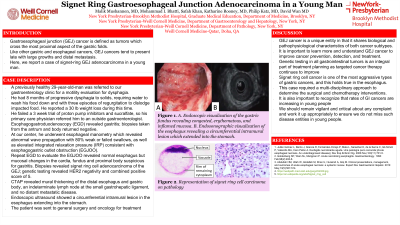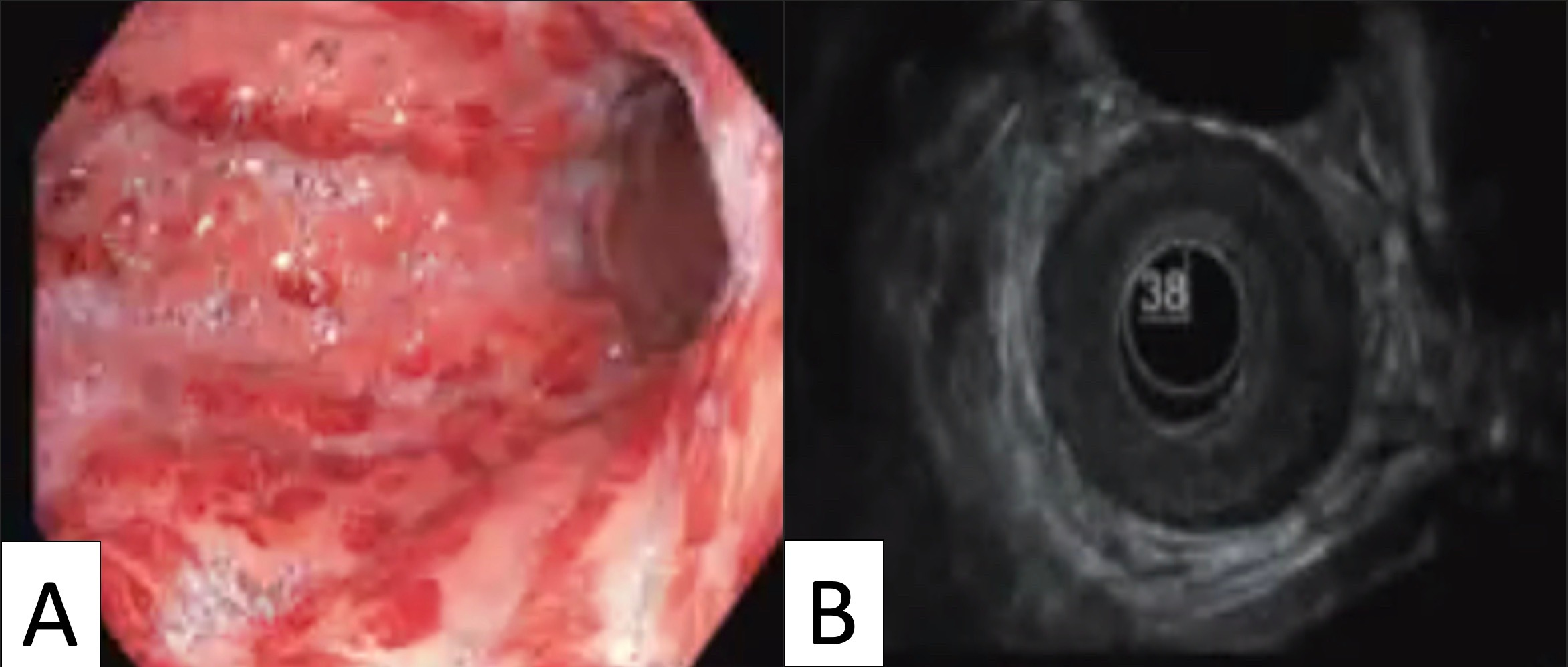Tuesday Poster Session
Category: Esophagus
P3348 - Signet Ring Gastroesophageal Junction Adenocarcinoma in a Young Man
Tuesday, October 24, 2023
10:30 AM - 4:00 PM PT
Location: Exhibit Hall

Has Audio

Malik Mushannen, MD
NYP-Brooklyn Methodist Hospital
Brooklyn, NY
Presenting Author(s)
Malik Mushannen, MD1, Mohammad I. Bhatti, 2, Katharine Rooney, MD3, Safah Khan, 2, Philip Katz, MD3, David Wan, BS, MD4
1NYP-Brooklyn Methodist Hospital, Brooklyn, NY; 2Weill Cornell Medicine-Qatar, Doha, Ad Dawhah, Qatar; 3NYP-Cornell, New York, NY; 4Weill Cornell Medicine, New York, NY
Introduction: Gastroesophageal junction (GEJ) cancer is defined as tumors which cross the most proximal aspect of the gastric folds. Like other gastric and esophageal cancers, GEJ cancers tend to present late with large growths and distal metastasis. Here, we report a case of signet-ring GEJ adenocarcinoma in a young man.
Case Description/Methods: A previously healthy 29-year-old-man was referred to our gastroenterology clinic for a motility evaluation in the setting of dysphagia. Over the past 8 months, he had been having progressive dysphagia to solids, requiring water to wash his food down and with three episodes of regurgitation to dislodge impacted food. He reported a 30 lb weight loss during this time. He failed a 3 week trial of proton pump inhibitors and sucralfate, at which point his primary care physician referred him to an outside gastroenterologist. Esophagogastroduodenoscopy (EGD) revealed gastritis; biopsies taken from the antrum and body returned negative. At our center, he underwent esophageal manometry which revealed abnormal wave propagation with 80% weak or failed swallows, as well as an elevated IRP consistent with esophagogastric outlet obstruction (EGJOO). Repeat EGD to evaluate the EGJOO was done, revealing normal esophagus but mucosal changes in the cardia, fundus and proximal body suspicious for gastritis. Biopsies taken revealed signet ring cell adenocarcinoma of the GEJ; molecular genetic testing revealed it to be HER2 negative and combined positive score of 5. CTAP revealed mural thickening of the distal esophagus and gastric body, an indeterminate lymph node at the small gastrohepatic ligament, and no distant metastatic disease. Endoscopic ultrasound showed a circumferential intramural lesion in the esophagus extending into the stomach. The patient was referred to general surgery and oncology for treatment planning.
Discussion: GEJ cancer is a unique entity in that it shares biological and pathophysiological characteristics of both cancer subtypes. For this reason, it is important to learn more and understand GEJ cancer to improve cancer prevention, detection, and treatment. With the improvement of targeted cancer therapy, genetic testing in all gastrointestinal tumors is an integral part of treatment planning. Signet ring cell cancer is one of the most aggressive types of gastric cancers, and this holds true in the esophagus. This case will require a multi-disciplinary approach to determine the surgical and chemotherapy interventions.

Disclosures:
Malik Mushannen, MD1, Mohammad I. Bhatti, 2, Katharine Rooney, MD3, Safah Khan, 2, Philip Katz, MD3, David Wan, BS, MD4. P3348 - Signet Ring Gastroesophageal Junction Adenocarcinoma in a Young Man, ACG 2023 Annual Scientific Meeting Abstracts. Vancouver, BC, Canada: American College of Gastroenterology.
1NYP-Brooklyn Methodist Hospital, Brooklyn, NY; 2Weill Cornell Medicine-Qatar, Doha, Ad Dawhah, Qatar; 3NYP-Cornell, New York, NY; 4Weill Cornell Medicine, New York, NY
Introduction: Gastroesophageal junction (GEJ) cancer is defined as tumors which cross the most proximal aspect of the gastric folds. Like other gastric and esophageal cancers, GEJ cancers tend to present late with large growths and distal metastasis. Here, we report a case of signet-ring GEJ adenocarcinoma in a young man.
Case Description/Methods: A previously healthy 29-year-old-man was referred to our gastroenterology clinic for a motility evaluation in the setting of dysphagia. Over the past 8 months, he had been having progressive dysphagia to solids, requiring water to wash his food down and with three episodes of regurgitation to dislodge impacted food. He reported a 30 lb weight loss during this time. He failed a 3 week trial of proton pump inhibitors and sucralfate, at which point his primary care physician referred him to an outside gastroenterologist. Esophagogastroduodenoscopy (EGD) revealed gastritis; biopsies taken from the antrum and body returned negative. At our center, he underwent esophageal manometry which revealed abnormal wave propagation with 80% weak or failed swallows, as well as an elevated IRP consistent with esophagogastric outlet obstruction (EGJOO). Repeat EGD to evaluate the EGJOO was done, revealing normal esophagus but mucosal changes in the cardia, fundus and proximal body suspicious for gastritis. Biopsies taken revealed signet ring cell adenocarcinoma of the GEJ; molecular genetic testing revealed it to be HER2 negative and combined positive score of 5. CTAP revealed mural thickening of the distal esophagus and gastric body, an indeterminate lymph node at the small gastrohepatic ligament, and no distant metastatic disease. Endoscopic ultrasound showed a circumferential intramural lesion in the esophagus extending into the stomach. The patient was referred to general surgery and oncology for treatment planning.
Discussion: GEJ cancer is a unique entity in that it shares biological and pathophysiological characteristics of both cancer subtypes. For this reason, it is important to learn more and understand GEJ cancer to improve cancer prevention, detection, and treatment. With the improvement of targeted cancer therapy, genetic testing in all gastrointestinal tumors is an integral part of treatment planning. Signet ring cell cancer is one of the most aggressive types of gastric cancers, and this holds true in the esophagus. This case will require a multi-disciplinary approach to determine the surgical and chemotherapy interventions.

Figure: A. Endoscopic visualization of the gastric fundus revealing congested, erythematous, and inflamed mucosa.
B. Endosonographic visualization of the esophagus revealing a circumferential intramural lesion which extended into the stomach.
B. Endosonographic visualization of the esophagus revealing a circumferential intramural lesion which extended into the stomach.
Disclosures:
Malik Mushannen indicated no relevant financial relationships.
Mohammad Bhatti indicated no relevant financial relationships.
Katharine Rooney indicated no relevant financial relationships.
Safah Khan indicated no relevant financial relationships.
Philip Katz indicated no relevant financial relationships.
David Wan indicated no relevant financial relationships.
Malik Mushannen, MD1, Mohammad I. Bhatti, 2, Katharine Rooney, MD3, Safah Khan, 2, Philip Katz, MD3, David Wan, BS, MD4. P3348 - Signet Ring Gastroesophageal Junction Adenocarcinoma in a Young Man, ACG 2023 Annual Scientific Meeting Abstracts. Vancouver, BC, Canada: American College of Gastroenterology.
